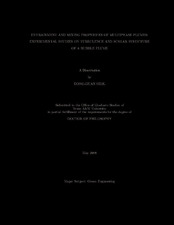| dc.contributor.advisor | Socolofsky, Scott A. | |
| dc.creator | Seol, Dong Guan | |
| dc.date.accessioned | 2010-01-15T00:13:01Z | |
| dc.date.accessioned | 2010-01-16T00:57:13Z | |
| dc.date.available | 2010-01-15T00:13:01Z | |
| dc.date.available | 2010-01-16T00:57:13Z | |
| dc.date.created | 2008-05 | |
| dc.date.issued | 2009-05-15 | |
| dc.identifier.uri | https://hdl.handle.net/1969.1/ETD-TAMU-2794 | |
| dc.description.abstract | This dissertation presents a series of laboratory experiments to study flow and mixing
properties of multiphase plumes. The particle image velocimetry (PIV) and laserinduced
fluorescence (LIF) techniques are developed to measure two-dimensional velocity
and concentration fields of multiphase plumes. The developed measurement
techniques are applied to bubble plumes in different ambient conditions.
The problems and errors in the two-phase PIV application to a bubble plume case
are addressed through a comparative study between the optical separation method
using fluorescent particles and a new phase separation method using vector postprocessing.
The study shows that the new algorithm predicts well the instantaneous
and time-averaged velocity profiles and has errors comparable to those for image
masking techniques.
The phase separation method developed in the previous section is applied to
study the mean flow characteristics of a bubble plume in quiescent and unstratified
condition. The entrainment coefficients representing the mixing properties of a bubble
plume are calculated to lie between 0.08 near the plume source and 0.05 in the upper
region, and to depend on the non-dimensional quantity us/(B/z)1/3, where us is the
bubble slip velocity, B is the initial buoyancy flux, and z is the height from the diffuser.
Further, the LIF technique is investigated to measure the scalar concentration
field around a bubble plume in quiescent, unstratified condition. This new application
to bubble plumes accounts for light scattering by bubbles using an attenuation coef-
ficient that is proportional to the local void fraction. Measured scalar concentration
fields show similar trend in concentration fluctuation to turbulent plume cases.
Finally, the velocity and concentration field measurements using the developed
two-phase PIV and LIF methods are applied for a bubble plume in a density-stratified
ambient. The turbulent flow characteristics induced by a bubble plume in a stratified
ambient water are studied. The plume fluctuation frequency is measured as about 0.1
Hz and compares well to plume wandering frequency measured in unstratified plume
cases. | en |
| dc.format.medium | electronic | en |
| dc.format.mimetype | application/pdf | |
| dc.language.iso | en_US | |
| dc.subject | bubble plume | en |
| dc.subject | PIV | en |
| dc.subject | LIF | en |
| dc.subject | mean flow properties | en |
| dc.subject | quantitative measurement of scalar concentration field | en |
| dc.subject | stratification | en |
| dc.title | Entrainment and mixing properties of multiphase plumes: Experimental studies on turbulence and scalar structure of a bubble plume | en |
| dc.type | Book | en |
| dc.type | Thesis | en |
| thesis.degree.department | Civil Engineering | en |
| thesis.degree.discipline | Ocean Engineering | en |
| thesis.degree.grantor | Texas A&M University | en |
| thesis.degree.name | Doctor of Philosophy | en |
| thesis.degree.level | Doctoral | en |
| dc.contributor.committeeMember | Chang, Kuang-An | |
| dc.contributor.committeeMember | Chen, Hamn-Ching | |
| dc.contributor.committeeMember | Hassan, Yassin A. | |
| dc.type.genre | Electronic Dissertation | en |
| dc.type.material | text | en |
| dc.format.digitalOrigin | born digital | en |


